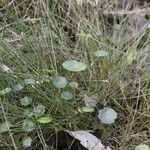A slender creeping herb. It has a thin trailing stem which forms roots along it. It is 10-40 cm long. The leaves are hairy underneath. They are 0.8-4 cm across. The leaf stalk joins the leaf blade in the centre of the leaf. The flowers are small. They are white or pink and on long stalks. The fruit are rounded and 2 mm across. They are ridged.










